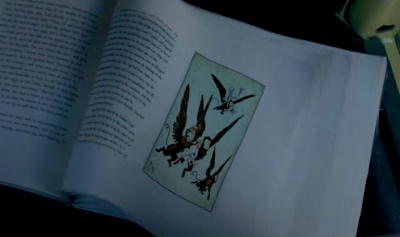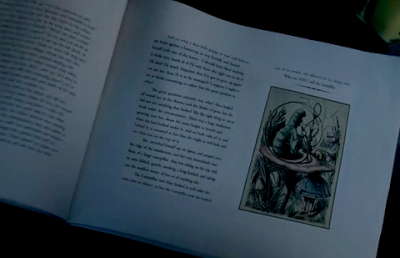The first episode of Once Upon a Time aired on ABC recently, and I wanted to share some insights and observations about the show that I am particularly suited for.
I should confess at this point that my professional writing career began with Oz Squad, a comic book I wrote sometime ago that took the characters from L Frank Baum’s The Wonderful Wizard of Oz and updated them into comic book style superheroes.
In no way am I saying that Once Upon a Time is derivative of my work on that series, but the new TV show, or at least the pilot, does approach classic children’s literature (though as we will see, that’s not quite true) with an eye towards updating it for a modern, more sophisticated audience.
The series begins with white lettering on a black screen that begins, appropriately enough for something concerned with fairy tales, “Once Upon a Time, there was an enchanted forest filled with all the classic characters we know. Or think we know. One day they found themselves trapped in a place where all their happy endings were stolen. Our World. This is how it happened…”
This is an interesting idea, and one that I found useful when writing Oz Squad.
The world of Oz was a veritable Utopia. Reading the novels of Baum and his successors, I sometimes wondered at how hard they had to work to create narratives with any real danger or suspense, since the deux ex machina of a magical solution to any problem was always just around the corner. In my comic, Oz was invaded by Earth, and the wound left during the invasion was the grist for my stories. Whenever you compare the fantasy of fairy tales like Baum’s to the reality of our mundane world, it is the latter that is found lacking. Still, I never felt that the real world was that bad, or that the fantasy land of Oz was that good. I was interested in poking at the fictions in both worlds.
In Once Upon a Time, the terribleness of Earth, the real world, is self-inflicted.
Like the motion picture Enchanted (2007), the wicked queen (in this case the witch from Snow White) has cast a spell that traps fantasy characters in the real world, with no knowledge of their former lives. But unlike Enchanted, in which the characters are able to bring fantasy world magic into reality, in Once Upon a Time the real world is winning, grinding the characters under the weight of ponderous, endless reality.
The episode begins with Prince Charming riding out to give the kiss of true love, (and life) to the poisoned Snow White. The Prince approaches the coffin in the middle of foul winter weather, and his kiss not only revives Snow White, it also dispels the bleak Winter world and brings back Spring, (keeping the tale in the realm of tales as old and as resent as Ishtar’s descent into the Underworld.)
The dwarves are not the generic characters from the original fairy tale but are modeled on those of the Disney animated version of Snow White and the Seven Dwarfs (1937). We can easily pick out Doc and Grumpy, for instance, at the wedding scene. This is possible because Once Upon a Time is an ABC production, and Disney owns ABC. You see, anyone can do a reimagining of the old Grimm fairy tales, but only Disney can use dwarfs named Doc, Sleepy, Sneezy, Happy, Grumpy, Dopey and Bashful. (Disney used the curious spelling dwarfs instead of the more proper dwarves when titling his film.) The credits list actors as playing Doc, Dopey, Sneezy and Bashful, in case anyone thinks I’m reading too much into this.
The plot of the series centers around a ten year old boy, the grandson of Snow White and Prince Charming, who has learned through a book of fairy tales that all the people of the town he is growing up in, Storybrook (Storybrooke, Story Book) are trapped fairy tale characters. The first person we meet in town is the boys psychiatrist, who we are told, is in reality Jimmy Cricket.
This is of course another clue that we’re firmly in Disney territory. In the original novel Pinocchio, by Carlo Collodi, Jiminy Cricket is stomped and killed by Pinocchio fairly early on. He’s a major character only in the Disney movie Pinocchio (1940). This reliance on the movies of Disney rather than the original tales is oddly problematic to me.
Several of the characters alluded to have no direct Disney connection, such as Rumplestiltskin, Red Riding Hood and The Wizard of Oz. There are references and allusions in the pilot to the Black Knight, an Arthurian character, and Alice’s Adventures in Wonderland.
 |
| Wizard of Oz |
 |
| Alice in Wonderland (the text is also from Alice) |
The stories collected by the Brother’s Grimm and authored by Hans Christian Anderson end sometimes happily, but often gruesomely, or just plain weird. For instance, at the end of Cinderella, the wicked stepsisters, in an attempt to fit their ogreish feet into the glass slipper, brutally cut off their toes and heels, only to fail to fool the Prince. The idea that the sisters are forever hobbled for their wickedness may be just desserts, but it’s weird, violent and not in keeping with Disney’s conception of fairy tales.
In order to make the point of the series, the creators needed a magical fairy tale world that was Utopian, to contrast it with the real world, which is several times in the pilot mentioned as being terrible and horrible. When people read actual fairy tales, they are often shocked by the raging sexual id the stories represent, and the outrageous, imaginative brutality. A real tackling of these tales, warts and all, would be very interesting, but instead the producers have decided to use the cleaned-up sanitized versions of the tales as represented in the popular imagination, especially Disney.
This is not to say that I didn’t enjoy the pilot. I found most of it rather interesting and engaging.
There were several good bits, especially the scene at the wedding near the beginning of the episode where Snow White draws Prince Charming’s sword to defend against the Wicked Witch. It was a rare moment of empowerment for a character too often portrayed as docile and simpering. Another great bit occurs near the end, when Prince Charming has been stabbed and is dying in Snow’s arms. In a moment of insight she kisses her husband to save him, the same way his kiss revived her, but of course, under the spell of the witch, the kiss was for naught.
I haven’t touched on the plot of the piece as a whole, nor have I gotten into the various characters such as Emma Swan (whose name is bursting with interesting connotations) or the previously mention Rumplestiltskin, portrayed as an Arkham Asylum imprisoned Joker or more likely Hannibal Lector. Interesting stuff, and it will hopefully have a big payoff.
For now the show is interesting, and I’ll continue to watch, keeping an eye out for interesting developments.















































































































